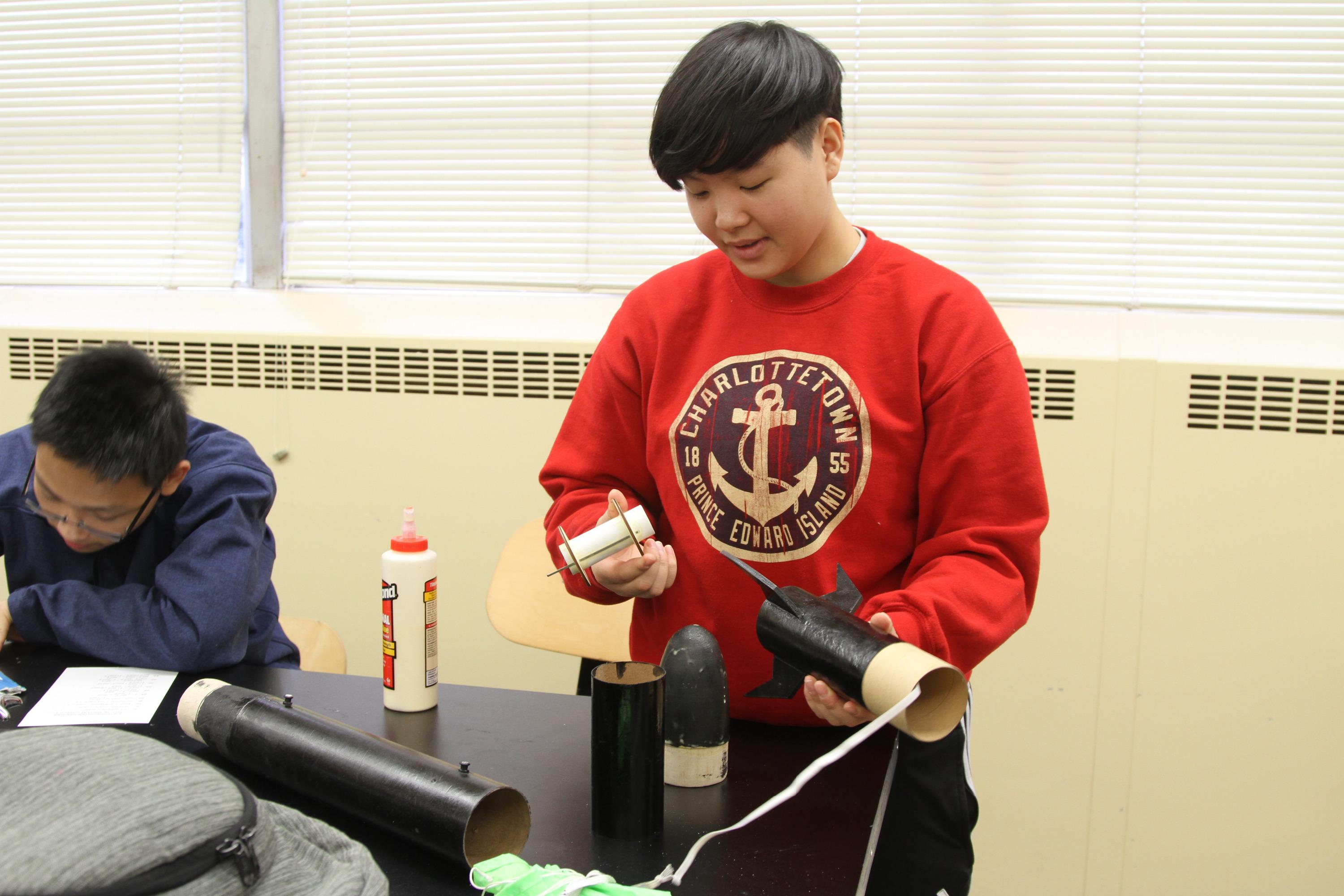
David Douglas High School senior Jayee Li works on a model rocket in an after-school class. It's part of the high school's Schools Uniting Neighborhoods, or SUN, program.
Rob Manning / OPB
For many Portland parents "SUN school" means cool, free, after-school classes — like this rocketry class at David Douglas High. Senior Jayee Li is hoping her new rocket will fly better than the last one.
"Because we used an engine that did not fit our engine mount, so it was not good," Li said as she checked to see if the paint on her rocket had dried.
Li is one of about 700 students attending after-school classes at Oregon's largest high school.
The county spends millions on programs at six school districts. But lately, leaders have pushed for more for their investment.
That push has put the state's largest county government at odds with David Douglas High.
Multnomah County wants to make major changes to "Schools Uniting Neighborhoods" — a program started 15 years ago that has grown to more than 80 area schools.
"SUN's job is not to provide after-school programs for every kid at the school. That's not a good use of taxpayer dollars — of county dollars," said Multnomah County chair, Deborah Kafoury.
"Our job is to look at who is not succeeding at schools, who needs extra help, whose family needs extra help."
Kafoury wants the SUN program to focus on closing the achievement gap between rich and poor students and white students, African-American students and other demographic groups.
The county's answer is to focus services toward certain cultures or ethnicities. About one-third of SUN schools would shift toward culturally-specific services — from about 30 percent now, to at least 60 percent starting in fall 2016. The county says its new focus will eliminate barriers, foster a sense of safety and result in better outcomes for students facing discrimination.

John Bier is the principal at David Douglas High School - the largest high school in Oregon, located in East Portland.
Rob Manning / OPB
David Douglas High School is slated to change to an African-American provider. Only about 10 percent of the high school's student body is black. But that's out of a total enrollment of about 3,200 students.
"I think [the change at David Douglas] is because of the schools in Multnomah County, they have the third highest number of African-American students attending school there," Kafoury said.
No other Multnomah County school district has pushed hard against the change, but some question the specifics. For instance, Parkrose Superintendent Karen Gray supports the program change saying it "make(s) absolute sense to me." But Gray questions the math Multnomah County used in assigning certain cultural designations to specific schools.
"One way I feel the county went wrong was in using total numbers of students by ethnicity versus the true arithmetic which is percentage of race compared to the whole student enrollment in order to make their determination of which culturally specific community based organization was for each school district," Gray said.
Portland Public Schools supports the change.
"This move also aligns with our racial equity policy," PPS spokeswoman Christine Miles said in a written statement. "Although the lead agency will be a culturally specific, no student of another racial background will be excluded from any community school services."

David Douglas High School has more than 3200 students from diverse backgrounds. A majority of students are ethnic minorities, with more Latino and Asian students than African-American students.
Rob Manning / OPB
Opposition to the change at David Douglas starts at the top, with Superintendent Don Grotting.
"I do know in some other school districts, they were not happy with some of their current SUN systems, and they looked forward to the change. In all of our sites, we were extremely pleased with the providers," Grotting said.
But Kafoury says the change is bigger than Oregon's largest high school. It's about demographics.
"It has huge implications for the future of Multnomah County — for everyone in Multnomah County - that of children in poverty living in Multnomah County, 67 percent of them are children of color," she said.
"It feels a bit like the decision was made at 50,000 feet," said John Bier, the principal at David Douglas High. "When and if the change does come down, the whole idea is it's a change we weren't prepared or wanting to make — but we're going to have to be the ones to consolidate our community around it."
Bier's community of students is just learning of the change. Senior Martin Warren is part of the Black Student Union — one of the first groups informed of the coming change.

Members of David Douglas High School's Black Student Union have spoken out against changing the contractor for the Schools Uniting Neighborhoods program at the school to an African-American specific contractor. From left: A'Davionna Brooms, Dezjiana Wright, Dawie Sado, Kehinde Timothy, Amaka Agum, Martin Warren, and African-American student liaison and BSU advisor, Etema Banks.
Rob Manning / OPB
"Why bring in someone that may be culturally different, but may not know how the school works, or how the students are at this school, instead of leaving what's here and what we have now as something that works?" Warren said.
Both the county and school officials agree there's more work to do to close achievement gaps. They also agree such improvements will require good relationships between schools, children, and their parents.
A'Davionna Brooms is also skeptical of the county's shift. She's a David Douglas senior who says her family is close to the current SUN school coordinator, an Asian American woman who graduated from David Douglas.
"My mom has even been involved in SUN. So, by bringing in a new person, we don't know if we're going to get that, like, reaching out to parents," Brooms said. "They just gave each school a color, which makes no sense to me, at all."
The graduation rate for African American students at David Douglas is 74 percent — compared to 63 percent statewide.
County leaders aren't condemning current programs. Kafoury says they want excellence for the money they're spending.
"This change is going to be hard. I have no doubt in my mind that there are going to be some bumps in the road ahead. And I wouldn't do it, if I didn't think it was that important," Kafoury said.
The transition is a concern for leaders at other Multnomah County school districts.
"We have great relationships with our existing providers and strong staff in those programs. That is where the challenge of the change rests," said Centennial School District Superintendent Samuel Breyer, who was part of a team that recommended the move. "However, we also know that this is an important step in serving a community that has undergone rapid and significant change."
The Gresham-Barlow school district offered a neutral response: "We have two schools that will be affected by this change from a regional provider to a more culturally specific provider. We will be working closely with the new provider to ensure the transition is a smooth one."
The county is expected to announce the new contractors later this month.
